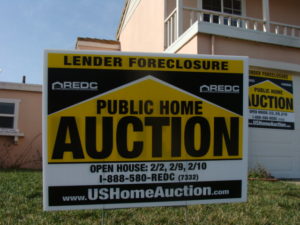
Foreclosed home in California during Subprime Meltdown. Image Credit: Brendel (CC by SA-3.0)
Market disruption occurs when markets stop functioning in a regular manner, often leading to large and rapid market declines. Market disruptions usually issue from physical threats to an industry or unusual trading, and are typically characterized by widespread panic and disorderly market conditions.
There are many potential causes for a market disruption. Severe weather or armed conflict that threatens a particular industry can often lead to disruption. Policy changes that are perceived by investors as threatening trade or international relations can also trigger disruptive behavior. A market disruption can also occur when fundamental weaknesses in an economy become publicly known. For instance, in 2007, large numbers of mortgages began to default, triggering the Subprime Meltdown. This in turn caused investors to question the liquidity and health of the economy, leading to the 2008 financial crisis.
Since the 1987 market crash, the market has contained systems to mitigate the adverse affects of disruption, such as circuit breakers and price limits. These systems are designed to put the brakes on trade in a rapidly declining market.

Recent Comments